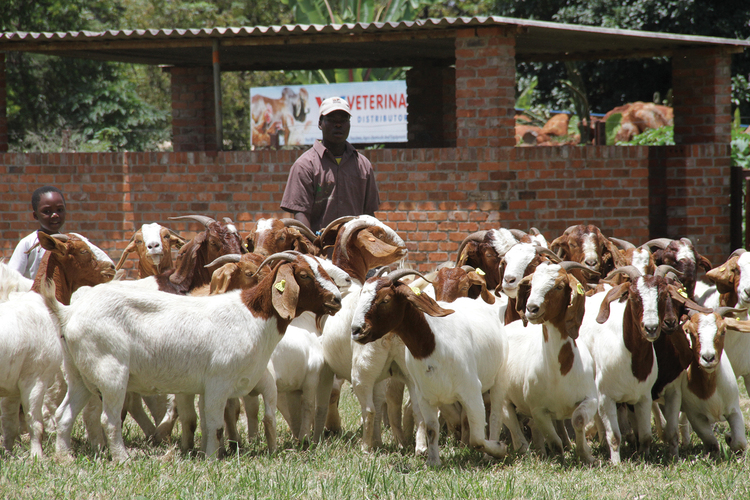High-value goats euphoria grips Beitbridge

Thupeyo Muleya Beitbridge Bureau
Successive droughts have brought agony to many farmers in the Matabeleland region, especially Beitbridge where crop production cannot do well under the current climatic conditions.
The situation has gradually worsened over the last few years due to the ongoing changes in the rainfall season.
This area falls under natural region 5 which is designated so for receiving erratic rainfall.
The district received around 200mm of rain during the last farming season and as a result, many people in this area who rely on farming as a business have turned to several adaptation methods.
These include irrigation, which is mostly powered by solar energy.
Livestock production, especially cattle, goats, and sheep have become the main economic activity in Beitbridge.
Due to droughts, many farmers had to watch in despair as their herds of cattle got decimated.
In the past two years, over 500 cattle succumbed to drought in Zimbabwe’s southern district. This has forced many members of the community to turn to goat production, taking into account that these survive on browsing and most breeds are drought tolerant.
The farmers have started taking goat production as a business and are migrating to higher-value breeds.
Proceeds from the sale of goats have seen many smallholder farmers writing success stories and being able to absorb the adverse effects of climate change.
It is understood that issues of health consciousness, milk value chain, and a marked increase in religious festivities have been pushing up goat production in Zimbabwe.
Renowned businessman and A1 farmer from the Lesanth area, Mr Chris Nguluvhe, said he started rearing goats in 1994 and has been migrating to better breeds in the last few years.
“I have over 70 Kalahari Red, Boer and Matabele breeds at both my rural home in Makakhavhule and Lesanth A1 farm,” he said. “I got the inspiration to upgrade my breed after attending one auction where some Boer and Kalahari goats were fetching prices above R200 000 each.
“Usually, I sell my stock once every February and the returns are encouraging. However, it must be noted that no business can thrive overnight. Those wishing to venture into the same projects must be patient for at least two years after kick-starting their initiatives.
“You will note that most businesses collapse within that period and if you find yourself running for over two years, they will not be easy to fall unless you decide to drop yourself.”
Another A1 farmer from the Joko area, ward 13, Mr Herbert Zhou said he became a serious goat farmer in 2016 when he imported 11 goats from the late Deyzel Xander of Polokwane in South Africa.
He now specialises in breeding Boer and crosses of Matabele and has at least 100 breeding does and around 30 various classes.
Mr Zhou said he was pushed by a combination of factors to upgrade the quality of his goats, which include the love of the breed, financial gains, and their influence on the meat production business industry.
“It has not been easy, producing high valued goats on an A1 farm because the setting is capital intensive, but one has to soldier one,” he said.
“In my case, I solved the headache of stock theft and threats from wild animals by using shepherd dogs and human shepherds. In addition, agriculture extension workers have been very helpful to many goat farmers around this area.”
Mr Zhou said on average a high-value breeding goat fetches US$1 000 on the local market. Mr Granger Nyoni said he set up his goats’ project at Juta Village in 2020, starting off with 19 female Matabele breeds and one Kalahari red buck.
“I now have 129 goats of mixed breeds and my target is to get to a threshold of 400 so that I can evenly supply the market,” he said.
“The demand for Boer, Kalahari Reds and crosses of Matabele is high and I have also bought several breeds of sheep.”
Youthful agronomist, Mr Ntandoyenkosi Ndlovu, has risen from a mere livestock fanatic to a renowned goat breeder in Zimbabwe and South Africa.
He started off renting a piece of land in Malala in Beitbridge, Ward 6, before migrating to South Africa where he has registered with the Boer Goats Breeders Association.
Mr Ndlovu now runs the Gatsheni Breeding Company which specialises in breeding Boer goats in Botswana, Namibia, South Africa and Zimbabwe.
“Now, I have 30 breeding ewes, and I get some goats from Namibia, Botswana and South Africa and supply them to the clients,” he said.
“It is pleasing to note that many people are migrating from ordinary goat breeds, which are sold for less than US$50 on the market compared to Boer and Kalahari breeds which can go for over US$500.
“These breeds are on-demand, they grow fast and also improve on multiple births from dropping one kid to two or four and have a good birth weight of an average of 3,5 kgs.”
Mr Ndlovu said climate change had affected a lot of things around livestock production, including the quality of grazing, and hence it was ideal to rear goats which did not require too much pasture like cattle.
Goats, he said, required little land to breed compared to huge animals.
“Goats multiply fast and within four years you may break even,” said Mr Ndlovu. “They grow faster and drop kids about three times in 24 months compared to cattle which drop calves once yearly.
“In fact, goat production is a short to mid-term investment that is seamless to set up. The demand for goats is high within SADC and across the globe. People are willing to pay a premium on these goats on the market.”
Beitbridge livestock specialist, Ms Cecelia Chakanyuka, said according to the second round crop assessment done in April, the district had 125 970 goats.
These, she said, include the indigenous Matabele, Boer, Cross (between Boer and Matabele), and the Kalahari Red.
Ms Chakanyuka said farmers should rear improved breeds, use artificial insemination, and avoid in-breeding (keeping bucks for more than four years such that they end up mating with their kids), to get high returns from goat production.
“In some instances, they must improve on supplementary feeds (fodder and feed formulation), and ideally, goats are more of browsers which survive on acacia species and veld grass,” she said.
“For supplements, the farmers may create fodder banks from lablab, velvet beans, lucerne, and bana grass.”
Ms Chakanyuka said a lot of education was being carried out by extension workers on goats’ vaccination, housing and the prevalence of common diseases such as pulpy kidney and heart-water.
It remains to be seen how the goat breeders and producers will fit into the ongoing Government thrust of transforming lives in rural areas through the goats-pass-on-scheme.
This is a programme that is set out to benefit up to three million households by the year 2025.









Comments